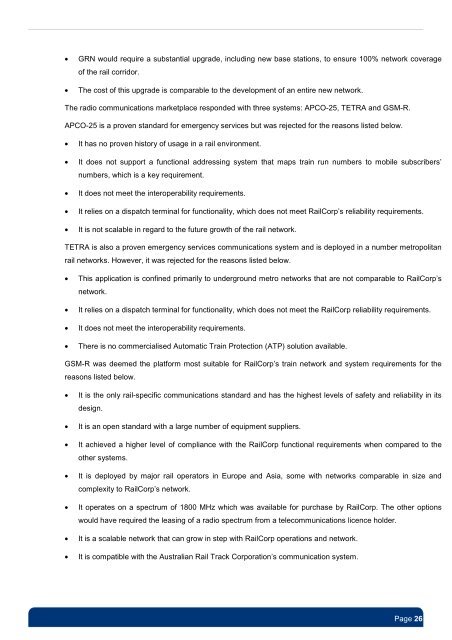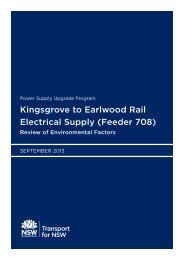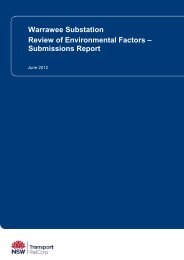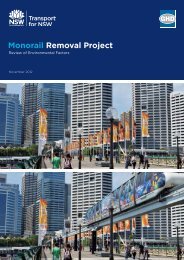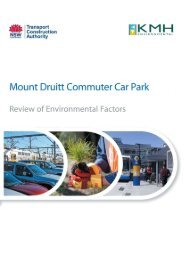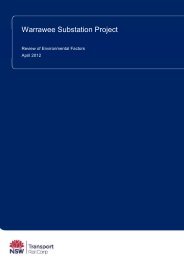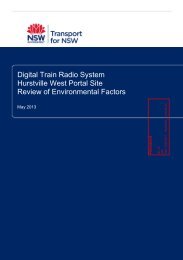Review of Environmental Factors - Transport for NSW - NSW ...
Review of Environmental Factors - Transport for NSW - NSW ...
Review of Environmental Factors - Transport for NSW - NSW ...
- No tags were found...
Create successful ePaper yourself
Turn your PDF publications into a flip-book with our unique Google optimized e-Paper software.
• GRN would require a substantial upgrade, including new base stations, to ensure 100% network coverage<strong>of</strong> the rail corridor.• The cost <strong>of</strong> this upgrade is comparable to the development <strong>of</strong> an entire new network.The radio communications marketplace responded with three systems: APCO-25, TETRA and GSM-R.APCO-25 is a proven standard <strong>for</strong> emergency services but was rejected <strong>for</strong> the reasons listed below.• It has no proven history <strong>of</strong> usage in a rail environment.• It does not support a functional addressing system that maps train run numbers to mobile subscribers’numbers, which is a key requirement.• It does not meet the interoperability requirements.• It relies on a dispatch terminal <strong>for</strong> functionality, which does not meet RailCorp’s reliability requirements.• It is not scalable in regard to the future growth <strong>of</strong> the rail network.TETRA is also a proven emergency services communications system and is deployed in a number metropolitanrail networks. However, it was rejected <strong>for</strong> the reasons listed below.• This application is confined primarily to underground metro networks that are not comparable to RailCorp’snetwork.• It relies on a dispatch terminal <strong>for</strong> functionality, which does not meet the RailCorp reliability requirements.• It does not meet the interoperability requirements.• There is no commercialised Automatic Train Protection (ATP) solution available.GSM-R was deemed the plat<strong>for</strong>m most suitable <strong>for</strong> RailCorp’s train network and system requirements <strong>for</strong> thereasons listed below.• It is the only rail-specific communications standard and has the highest levels <strong>of</strong> safety and reliability in itsdesign.• It is an open standard with a large number <strong>of</strong> equipment suppliers.• It achieved a higher level <strong>of</strong> compliance with the RailCorp functional requirements when compared to theother systems.• It is deployed by major rail operators in Europe and Asia, some with networks comparable in size andcomplexity to RailCorp’s network.• It operates on a spectrum <strong>of</strong> 1800 MHz which was available <strong>for</strong> purchase by RailCorp. The other optionswould have required the leasing <strong>of</strong> a radio spectrum from a telecommunications licence holder.• It is a scalable network that can grow in step with RailCorp operations and network.• It is compatible with the Australian Rail Track Corporation’s communication system.Page 26 <strong>of</strong> 67


